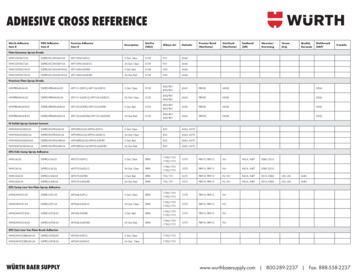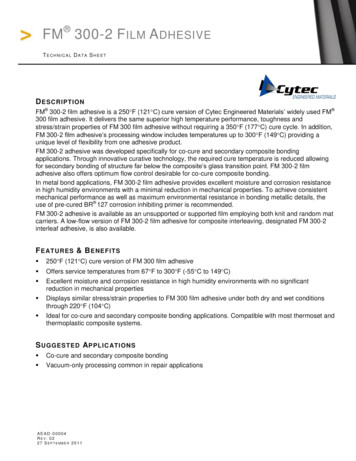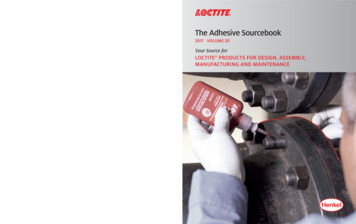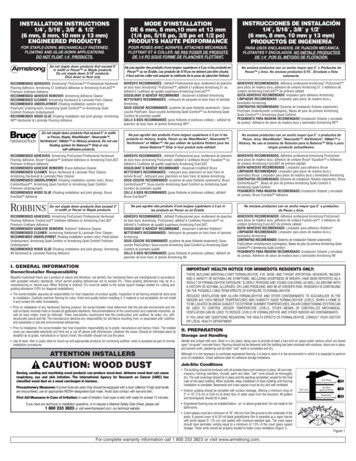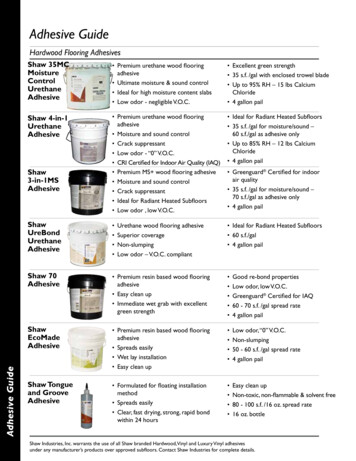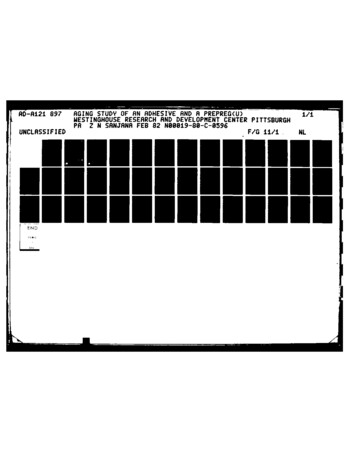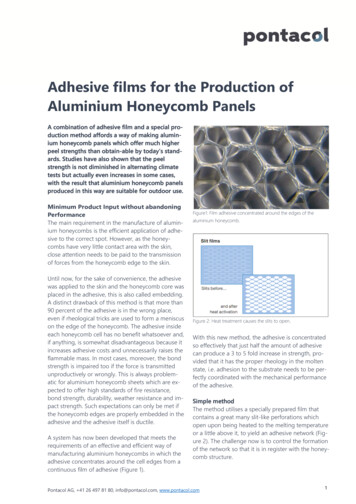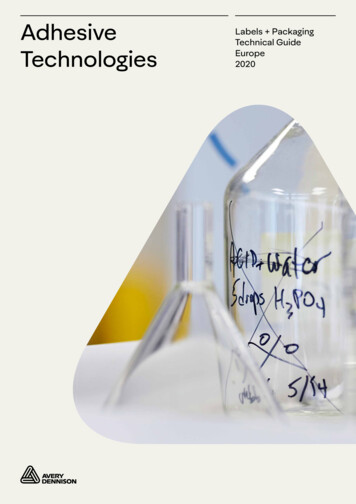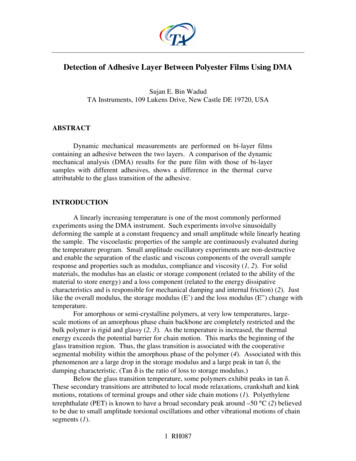
Transcription
Detection of Adhesive Layer Between Polyester Films Using DMASujan E. Bin WadudTA Instruments, 109 Lukens Drive, New Castle DE 19720, USAABSTRACTDynamic mechanical measurements are performed on bi-layer filmscontaining an adhesive between the two layers. A comparison of the dynamicmechanical analysis (DMA) results for the pure film with those of bi-layersamples with different adhesives, shows a difference in the thermal curveattributable to the glass transition of the adhesive.INTRODUCTIONA linearly increasing temperature is one of the most commonly performedexperiments using the DMA instrument. Such experiments involve sinusoidallydeforming the sample at a constant frequency and small amplitude while linearly heatingthe sample. The viscoelastic properties of the sample are continuously evaluated duringthe temperature program. Small amplitude oscillatory experiments are non-destructiveand enable the separation of the elastic and viscous components of the overall sampleresponse and properties such as modulus, compliance and viscosity (1, 2). For solidmaterials, the modulus has an elastic or storage component (related to the ability of thematerial to store energy) and a loss component (related to the energy dissipativecharacteristics and is responsible for mechanical damping and internal friction) (2). Justlike the overall modulus, the storage modulus (E’) and the loss modulus (E”) change withtemperature.For amorphous or semi-crystalline polymers, at very low temperatures, largescale motions of an amorphous phase chain backbone are completely restricted and thebulk polymer is rigid and glassy (2, 3). As the temperature is increased, the thermalenergy exceeds the potential barrier for chain motion. This marks the beginning of theglass transition region. Thus, the glass transition is associated with the cooperativesegmental mobility within the amorphous phase of the polymer (4). Associated with thisphenomenon are a large drop in the storage modulus and a large peak in tan , thedamping characteristic. (Tan δ is the ratio of loss to storage modulus.)Below the glass transition temperature, some polymers exhibit peaks in tan .These secondary transitions are attributed to local mode relaxations, crankshaft and kinkmotions, rotations of terminal groups and other side chain motions (1). Polyethyleneterephthalate (PET) is known to have a broad secondary peak around –50 C (2) believedto be due to small amplitude torsional oscillations and other vibrational motions of chainsegments (1).1 RH087
Adhesives usually have lower molecular weight than structural polymers. Hence,their glass transition is lower than the PET films that sandwich the different adhesives.EXPERIMENTALThe samples consist of two films of PET with a layer of adhesive between them.There are two such samples, each containing the same grade of PET, but differentadhesives. Two multilayer films each with a different adhesive are compared with the“pure” PET film. Thus, there were 3 samples with the following characteristics:1. Control : single PET film, no adhesives2. Sample A : PET/Adhesive 1/PET film3. Sample B : PET/Adhesive 2/PET filmTension-film clamps were used with the Q800 DMA. The samples are loaded withcare to ensure that there are no twists or folds. The load was added to the samples so thatno pulsation of the sample was observed when viewed from the side. The instrumentdetermines the exact length of the sample when the experiment is initiated. The sample isheated from –150 to 200 C at 3 C/min with a frequency of 1 Hz an amplitude of20 µm.RESULTS AND DISCUSSIONFigure 1 shows the storage modulus (in the solid line), the loss modulus (in thedashed line), and tan δ (in the dot-dashed line) of the control sample changing as afunction of temperature. Two runs were performed to estimate the repeatability of 00.0510-200-150-100-5005010015010200Universal V3.2B TA InstrumentsFigure 1 – DMA Curve of the Control PET Sample (no adhesive)There seem to be two transition regions in Figure 1. The first of these is the glasstransition near 120 C and the second is the broad γ transition near – 70 C characteristicof PET (4,5).2 RH087
1000010000E'E"0.10100[ – – – – ] Loss Modulus (MPa)1001000[ ––––– · ] Tan DeltaStorage Modulus (MPa)0.1510000.05tan deltaSample AControl Sample10-200-150-100-50050100Temperature ( C)10200150Universal V3.2B TA InstrumentsFigure 2 - Comparison of the PET Control and Sample A1000010000E'E"0.10100100[ – – – – ] Loss Modulus (MPa)1000[ ––––– · ] Tan DeltaStorage Modulus (MPa)0.1510000.05tan delta10-200Sample BControl Sample-150-100-500Temperature ( C)5010015010200Universal V3.2B TA InstrumentsFigure 3 - Comparison of PET Control and Sample BFigure 2 and Figure 3 show the temperature profiles of A and B samples respectively. Acomparison with the control sample results in Figure 1, shows that there is a subtle tan δpeak in Sample A at –57 C and one for Sample B at 19 C. These peaks are alsoobserved in the E” signal. These additional peaks are thought to be due to the adhesivelayers sandwiched between the two PET films.The storage modulus (E’) extrapolated onset temperature, the loss modulus (E” )and tan δ peak temperatures all used to indicate the glass transition temperature (Tg) attimes. ASTM International Standard E1640 identifies the storage modulus onsettemperature as the preferred indicator of glass transition (6). The following table showsthe Tg of the three samples using different methods:3 RH087
Table 1 - The Glass Transition Temperature of the Control, Sample Aand Sample B, Using Different SignalsSampleControlABE’ Onset( C)93.291.091.9E” peak( C)103.0102.7103.4Tan(δδ) peak( C)117.7116.0116.2Since the adhesive does not interact with the PET chemically, the Tg, does notchange in samples A and B.SUMMARYThe DMA is able to identify the glass transitions of a thin adhesive layers in thepresence of a large excess of the adhered PET films. The glass transition temperaturesare nearly 70 C different for the two samples indicating that the laminated films areintended for different service.REFERENCES1.2.3.4.5.6.John D. Ferry, Viscoelastic Properties of Polymers, 3rd Ed., John Wiley & Sons,1980.Takayuki Murayama, Dynamic Mechanical Analysis of Polymeric Material,Elsevier Scientific, 1978.Adi Eisenberg, “The Glassy State and the Glass Transition” , Physical Propertiesof Polymers, American Chemical Society, 1984.S. W. Shalaby, “Thermoplastic Polymers,” in Thermal Characterization ofPolymeric Materials, E. A. Turi (Ed.), Academic Press, 1981, p. 245.L. E. Nielsen, R. F. Landel, Mechanical Properties of Polymers and Composites,2nd Ed., Marcel Dekker, 1994, Chapter 4.E 1640, “Assignment of the Glass Transition Temperature by DMA” , AmericanSociety for Testing and Materials International, West Conshohocken, PA.KEYWORDSadhesives, dynamic mechanical analysis, films/fibers, glass transition, modulus,molecular spectrum, thermoplastic polymers4 RH087
TA InstrumentsUnited States, 109 Lukens Drive, New Castle, DE 19720 Phone: 1-302-427-4000 Fax: 1-302-427-4001E-mail: info@tainstruments.comSpain Phone: 34-93-600-9300 Fax: 34-93-325-9896 E-mail: spain@tainstruments.comUnited Kingdom Phone: 44-1-372-360363 Fax: 44-1-372-360135 E-mail: uk@tainstruments.comBelgium/Luxembourg Phone: 32-2-706-0080 Fax: 32-2-706-0081E-mail: belgium@tainstruments.comNetherlands Phone: 31-76-508-7270 Fax: 31-76-508-7280E-mail: netherlands@tainstruments.comGermany Phone: 49-6023-9647-0 Fax: 49-6023-96477-7 E-mail: germany@tainstruments.comFrance Phone: 33-1-304-89460 Fax: 33-1-304-89451 E-mail: france@tainstruments.comItaly Phone: 39-02-27421-283 Fax: 39-02-2501-827 E-mail: italia@tainstruments.comSweden/Norway Phone: 46-8-594-69-200 Fax: 46-8-594-69-209E-mail: sweden@tainstruments.comJapan Phone: 813 5479 8418) Fax: 813 5479 7488 E-mail: nurayama@taij.po-jp.comAustralia Phone: 613 9553 0813 Fax: 61 3 9553 0813 E-mail: steve shamis@waters.comTo contact your local TA Instruments representative visit our website at www.tainst.com5 RH087
adhesives. Two multilayer films each with a different adhesive are compared with the "pure" PET film. Thus, there were 3 samples with the following characteristics: 1. Control : single PET film, no adhesives 2. Sample A : PET/Adhesive 1/PET film 3. Sample B : PET/Adhesive 2/PET film Tension-film clamps were used with the Q800 DMA.
